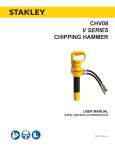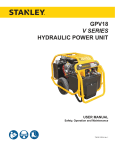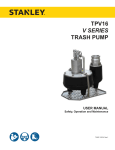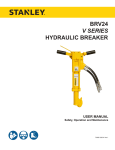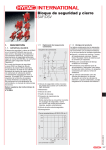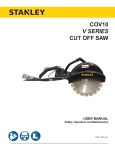Download DSV10 User Manual 1-2014 V1
Transcript
DSV10 V SERIES DIAMOND CHAIN SAW USER MANUAL Safety, Operation and Maintenance 73425 1/2014 Ver. 1 2 ► DSV10 User Manual TABLE OF CONTENTS SAFETY SYMBOLS................................................................................................................................................................................................ 4 SAFETY PRECAUTIONS........................................................................................................................................................................................ 5 TOOL STICKERS & TAGS...................................................................................................................................................................................... 7 HOSE TYPES.......................................................................................................................................................................................................... 8 HOSE RECOMMENDATIONS................................................................................................................................................................................ 9 FIGURE 1. TYPICAL HOSE CONNECTIONS.................................................................................................................................................... 9 HTMA REQUIREMENTS....................................................................................................................................................................................... 10 OPERATION...........................................................................................................................................................................................................11 TOOL PROTECTION & CARE.............................................................................................................................................................................. 14 TROUBLESHOOTING.......................................................................................................................................................................................... 15 SPECIFICATIONS................................................................................................................................................................................................. 16 IMPORTANT To fill out a Product Warranty Recording form, and for information on your warranty, visit Stanleyhydraulic.com and select the Warranty tab. (NOTE: The warranty recording form must be submitted to validate the warranty). SERVICING: This manual contains safety, operation, and routine maintenance instructions. Stanley Hydraulic Tools recommends that servicing of hydraulic tools, other than routine maintenance, must be performed by an authorized and certified dealer. Please read the following warning. WARNING SERIOUS INJURY OR DEATH COULD RESULT FROM THE IMPROPER REPAIR OR SERVICE OF THIS TOOL. REPAIRS AND / OR SERVICE TO THIS TOOL MUST ONLY BE DONE BY AN AUTHORIZED AND CERTIFIED DEALER. For the nearest authorized and certified dealer, call Stanley Hydraulic Tools at (503-659-5660) and ask for a Customer Service Representative. DSV10 User Manual ◄ 3 SAFETY SYMBOLS Safety symbols and signal words, as shown below, are used to emphasize all operator, maintenance and repair actions which, if not strictly followed, could result in a life-threatening situation, bodily injury or damage to equipment. This is the safety alert symbol. It is used to alert you to potential personal injury hazards. Obey all safety messages that follow this symbol to avoid possible injury or death. DANGER This safety alert and signal word indicate an imminently hazardous situation which, if not avoided, will result in death or serious injury. WARNING This safety alert and signal word indicate a potentially hazardous situation which, if not avoided, could result in death or serious injury. CAUTION This safety alert and signal word indicate a potentially hazardous situation which, if not avoided, could result in death or serious injury. CAUTION This signal word indicates a potentially hazardous situation which, if not avoided, may result in property damage. NOTICE This signal word indicates a situation which, if not avoided, will result in damage to the equipment. IMPORTANT This signal word indicates a situation which, if not avoided, may result in damage to the equipment. Always observe safety symbols. They are included for your safety and for the protection of the tool. LOCAL SAFETY REGULATIONS Enter any local safety regulations here. Keep these instructions in an area accessible to the operator and maintenance personnel. 4 ► DSV10 User Manual SAFETY PRECAUTIONS Tool operators and maintenance personnel must always comply with the safety precautions given in this manual and on the stickers and tags attached to the tool and hose. • Do not rely exclusively upon the safety devices built into the chain saw. As a chain saw user, several steps must be taken to keep your cutting jobs free from accident or injury: These safety precautions are given for your safety. Review them carefully before operating the tool and before performing general maintenance or repairs. a. With a basic understanding of kickbacks, you can reduce or eliminate the element of surprise. Sudden surprise contributes to accidents. Supervising personnel should develop additional precautions relating to the specific work area and local safety regulations. If so, place the added precautions in the space provided in this manual. b. Keep a good firm grip on the chain saw with both hands, the right hand on the rear handle and the left hand on the front handle when operating the chain saw. Use a firm grip with thumbs and fingers encircling the chain saw handles. A firm grip helps reduce kickbacks and maintains control of the chain saw. Do not let go. The DSV10 Concrete Chain Saw will provide safe and dependable service if operated in accordance with the instructions given in this manual. Read and understand this manual and any stickers and tags attached to the tool and hoses before operation. Failure to do so could result in personal injury or equipment damage. c. Make sure the area in which you are cutting is free of obstructions. d. Cut at rated operating speeds (gpm). e. Do not overreach or cut above shoulder height. f. Only use replacement bars and chains specified by Stanley Hydraulic Tools or the equivalent. • Make sure the chain guard is in place before operating the chain saw. • Remove or control the water slurry to prevent yourself or others from slipping while cutting. • Provide adequate ventilation in closed areas when operating a gas or diesel hydraulic power source. • Establish a training program for all operators to ensure safe operation. • The operator must be familiar with all prohibited work areas such as excessive slopes and dangerous terrain conditions. • Do not operate the chain saw unless thoroughly trained or under the supervision of an instructor. • Do not operate a hydraulic power source or a hydraulic diamond saw in an explosive atmosphere. • Always wear safety equipment such as goggles, ear, breathing, head protection, leg protection, gloves, snug fitting clothing and safety shoes at all times when operating the chain saw. • • Do not overreach. Maintain proper footing and balance at all times. • Do not inspect or clean the chain saw while the hydraulic power source is connected. Accidental engagement of the chain saw can cause serious injury. • Always connect hoses to the chain saw hose couplers before energizing the hydraulic power source. Make sure all hose connections are tight. Warning: Use of this tool on certain materials during demolition could generate dust potentially containing a variety of hazardous substances such as asbestos, silica or lead. Inhalation of dust containing these or other hazardous substances could result in serious injury, cancer or death. Protect yourself and those around you. Research and understand the materials you are cutting. Follow correct safety procedures and comply with all applicable national, state or provisional health and safety regulations relating to them, including, if appropriate arranging for the safe disposal of the materials by a qualified person. • Do not operate the chain saw at fluid temperatures above 140 °F/60 °C. Operation at higher temperatures can cause higher than normal temperatures at the chain saw which can result in operator discomfort. DSV10 User Manual ◄ 5 SAFETY PRECAUTIONS • Always be well rested and mentally alert before operating the chain saw. • Check all chain breaker and rivet spinner components regularly for wear and general condition. • Do not allow bystanders near the chain saw when starting or cutting. • Avoid contact with the saw bar rails as they can become very sharp during use. • Do not start cutting until you have a clear work area and secure footing. • Provide adequate lighting when operating the saw in a darkened area or at night. • Keep all parts of the body away from the chain saw during operation, including loose clothing and long hair. • Always keep critical tool markings, such as labels and warning stickers legible. Always replace stickers and decals that have become worn or damaged. • Carry the chain saw with the tool de-energized and the bar and chain to the rear of your body. • • Do not operate a chain saw that is damaged, improperly adjusted, or not completely and securely assembled. Make sure the chain stops moving when the control trigger is released. Be observant of hydraulic and water hoses that lay about the work area, especially in trenches where they can be hidden from view due to liquids that have accumulated within the space. • Keep all parts of the body away from the cleats that are attached to the saw, as these are sharp and can be a puncture hazard. • Improper handling, use, or maintenance can result in an oil leak or burst. Do not contact an oil leak as high pressure oil can cause injection into the body. • Never stand in the path of the discharge, as ejection of material from the work piece can cause personal injury. • Never use the saw in a potentially explosive atmosphere. • WARNING: Hydraulic fluid under pressure could cause skin injection injury. If you are injured by hydraulic fluid, get medical attention immediately. • Keep the handle dry, clean and free of hydraulic fluid. • Do not use the chain saw near energized transmission lines. • Turn off the power source or move the hydraulic control valve to neutral before setting the chain saw down. • Use a guide bar scabbard when transporting the chain saw. • Know the location of buried or covered utilities before starting work. • To avoid personal injury or equipment damage, all chain saw repair, maintenance and service must only be performed by authorized and properly trained personnel. • Make sure the chain breaker and rivet spinner are securely mounted on flat, clean work surfaces. Check the mounting screws/bolts often. 6 ► DSV10 User Manual TOOL STICKERS & TAGS D A N G E R 1. FAILURE TO USE HYDRAULIC HOSE LABELED AND CERTIFIED AS NON-CONDUCTIVE WHEN USING HYDRAULIC TOOLS ON OR NEAR ELECTRICAL LINES MAY RESULT IN DEATH OR SERIOUS INJURY. BEFORE USING HOSE LABELED AND CERTIFIED AS NONCONDUCTIVE ON OR NEAR ELECTRIC LINES BE SURE THE HOSE IS MAINTAINED AS NON-CONDUCTIVE. THE HOSE SHOULD BE REGULARLY TESTED FOR ELECTRIC CURRENT LEAKAGE IN ACCORDANCE WITH YOUR SAFETY DEPARTMENT INSTRUCTIONS. 2. A HYDRAULIC LEAK OR BURST MAY CAUSE OIL INJECTION INTO THE BODY OR CAUSE OTHER SEVERE PERSONAL INJURY. A. DO NOT EXCEED SPECIFIED FLOW AND PRESSURE FOR THIS TOOL. EXCESS FLOW OR PRESSURE MAY CAUSE A LEAK OR BURST. B. DO NOT EXCEED RATED WORKING PRESSURE OF HYDRAULIC HOSE USED WITH THIS TOOL. EXCESS PRESSURE MAY CAUSE A LEAK OR BURST. C. CHECK TOOL HOSE COUPLERS AND CONNECTORS DAILY FOR LEAKS. DO NOT FEEL FOR LEAKS WITH YOUR HANDS. CONTACT WITH A LEAK MAY RESULT IN SEVERE PERSONAL INJURY. The safety tag (P/N 15875) at right is attached to the tool when shipped from the factory. Read and understand the safety instructions listed on this tag before removal. We suggest you retain this tag and attach it to the tool when not in use. D A N G E R D. DO NOT LIFT OR CARRY TOOL BY THE HOSES. DO NOT ABUSE HOSE. DO NOT USE KINKED, TORN OR DAMAGED HOSE. 3. MAKE SURE HYDRAULIC HOSES ARE PROPERLY CONNECTED TO THE TOOL BEFORE PRESSURING SYSTEM. SYSTEM PRESSURE HOSE MUST ALWAYS BE CONNECTED TO TOOL “IN” PORT. SYSTEM RETURN HOSE MUST ALWAYS BE CONNECTED TO TOOL “OUT” PORT. REVERSING CONNECTIONS MAY CAUSE REVERSE TOOL OPERATION WHICH CAN RESULT IN SEVERE PERSONAL INJURY. 4. DO NOT CONNECT OPEN-CENTER TOOLS TO CLOSEDCENTER HYDRAULIC SYSTEMS. THIS MAY RESULT IN LOSS OF OTHER HYDRAULIC FUNCTIONS POWERED BY THE SAME SYSTEM AND/OR SEVERE PERSONAL INJURY. 5. BYSTANDERS MAY BE INJURED IN YOUR WORK AREA. KEEP BYSTANDERS CLEAR OF YOUR WORK AREA. 6. WEAR HEARING, EYE, FOOT, HAND AND HEAD PROTECTION. 7. TO AVOID PERSONAL INJURY OR EQUIPMENT DAMAGE, ALL TOOL REPAIR MAINTENANCE AND SERVICE MUST ONLY BE PERFORMED BY AUTHORIZED AND PROPERLY TRAINED PERSONNEL. I M P O R T A N T I M P O R T A N T READ OPERATION MANUAL AND SAFETY INSTRUCTIONS FOR THIS TOOL BEFORE USING IT. READ OPERATION MANUAL AND SAFETY INSTRUCTIONS FOR THIS TOOL BEFORE USING IT. USE ONLY PARTS AND REPAIR PROCEDURES APPROVED BY STANLEY AND DESCRIBED IN THE OPERATION MANUAL. USE ONLY PARTS AND REPAIR PROCEDURES APPROVED BY STANLEY AND DESCRIBED IN THE OPERATION MANUAL. TAG TO BE REMOVED ONLY BY TOOL OPERATOR. TAG TO BE REMOVED ONLY BY TOOL OPERATOR. SEE OTHER SIDE SEE OTHER SIDE SAFETY TAG P/N 15875 (Shown smaller then actual size) DSV10 User Manual ◄ 7 HOSE TYPES The rated working pressure of the hydraulic hose must be equal to or higher than the relief valve setting on the hydraulic system. There are three types of hydraulic hose that meet this requirement and are authorized for use with Stanley Hydraulic Tools. They are: Certified non-conductive — constructed of thermoplastic or synthetic rubber inner tube, synthetic fiber braid reinforcement, and weather resistant thermoplastic or synthetic rubber cover. Hose labeled certified nonconductive is the only hose authorized for use near electrical conductors. Wire-braided (conductive) — constructed of synthetic rubber inner tube, single or double wire braid reinforcement, and weather resistant synthetic rubber cover. This hose is conductive and must never be used near electrical conductors. Fabric-braided (not certified or labeled non-conductive) — constructed of thermoplastic or synthetic rubber inner tube, synthetic fiber braid reinforcement, and weather resistant thermoplastic or synthetic rubber cover. This hose is not certified non-conductive and must never be used near electrical conductors. HOSE SAFETY TAGS To help ensure your safety, the following DANGER tags are attached to all hose purchased from Stanley Hydraulic Tools. DO NOT REMOVE THESE TAGS. If the information on a tag is illegible because of wear or damage, replace the tag immediately. A new tag may be obtained from your Stanley Distributor. D A N G E R D A N G E R 1. FAILURE TO USE HYDRAULIC HOSE LABELED AND CERTIFIED AS NON-CONDUCTIVE WHEN USING HYDRAULIC TOOLS ON OR NEAR ELECTRIC LINES MAY RESULT IN DEATH OR SERIOUS INJURY. FOR PROPER AND SAFE OPERATION MAKE SURE THAT YOU HAVE BEEN PROPERLY TRAINED IN CORRECT PROCEDURES REQUIRED FOR WORK ON OR AROUND ELECTRIC LINES. 2. BEFORE USING HYDRAULIC HOSE LABELED AND CERTIFIED AS NON-CONDUCTIVE ON OR NEAR ELECTRIC LINES. WIPE THE ENTIRE LENGTH OF THE HOSE AND FITTING WITH A CLEAN DRY ABSORBENT CLOTH TO REMOVE DIRT AND MOISTURE AND TEST HOSE FOR MAXIMUM ALLOWABLE CURRENT LEAKAGE IN ACCORDANCE WITH SAFETY DEPARTMENT INSTRUCTIONS. 3. DO NOT EXCEED HOSE WORKING PRESSURE OR ABUSE HOSE. IMPROPER USE OR HANDLING OF HOSE COULD RESULT IN BURST OR OTHER HOSE FAILURE. KEEP HOSE AS FAR AWAY AS POSSIBLE FROM BODY AND DO NOT PERMIT DIRECT CONTACT DURING USE. CONTACT AT THE BURST CAN CAUSE BODILY INJECTION AND SEVERE PERSONAL INJURY. 4. HANDLE AND ROUTE HOSE CAREFULLY TO AVOID KINKING, ABRASION, CUTTING, OR CONTACT WITH HIGH TEMPERATURE SURFACES. DO NOT USE IF KINKED. DO NOT USE HOSE TO PULL OR LIFT TOOLS, POWER UNITS, ETC. 5. CHECK ENTIRE HOSE FOR CUTS CRACKS LEAKS ABRASIONS, BULGES, OR DAMAGE TO COUPLINGS IF ANY OF THESE CONDITIONS EXIST, REPLACE THE HOSE IMMEDIATELY. NEVER USE TAPE OR ANY DEVICE TO ATTEMPT TO MEND THE HOSE. 6. AFTER EACH USE STORE IN A CLEAN DRY AREA. SEE OTHER SIDE SIDE 1 SEE OTHER SIDE (Shown smaller than actual size) DO NOT REMOVE THIS TAG DO NOT REMOVE THIS TAG THE TAG SHOWN BELOW IS ATTACHED TO “CERTIFIED NON-CONDUCTIVE” HOSE SIDE 2 D A N G E R D A N G E R 1. DO NOT USE THIS HYDRAULIC HOSE ON OR NEAR ELECTRIC LINES. THIS HOSE IS NOT LABELED OR CERTIFIED AS NON-CONDUCTIVE. USING THIS HOSE ON OR NEAR ELECTRICAL LINES MAY RESULT IN DEATH OR SERIOUS INJURY. 5. CHECK ENTIRE HOSE FOR CUTS CRACKS LEAKS ABRASIONS, BULGES, OR DAMAGE TO COUPLINGS IF ANY OF THESE CONDITIONS EXIST, REPLACE THE HOSE IMMEDIATELY. NEVER USE TAPE OR ANY DEVICE TO ATTEMPT TO MEND THE HOSE. 2. FOR PROPER AND SAFE OPERATION MAKE SURE THAT YOU HAVE BEEN PROPERLY TRAINED IN CORRECT PROCEDURES REQUIRED FOR WORK ON OR AROUND ELECTRIC LINES. 6. AFTER EACH USE STORE IN A CLEAN DRY AREA. 3. DO NOT EXCEED HOSE WORKING PRESSURE OR ABUSE HOSE. IMPROPER USE OR HANDLING OF HOSE COULD RESULT IN BURST OR OTHER HOSE FAILURE. KEEP HOSE AS FAR AWAY AS POSSIBLE FROM BODY AND DO NOT PERMIT DIRECT CONTACT DURING USE. CONTACT AT THE BURST CAN CAUSE BODILY INJECTION AND SEVERE PERSONAL INJURY. 4. HANDLE AND ROUTE HOSE CAREFULLY TO AVOID KINKING, CUTTING, OR CONTACT WITH HIGH TEMPERATURE SURFACES. DO NOT USE IF KINKED. DO NOT USE HOSE TO PULL OR LIFT TOOLS, POWER UNITS, ETC. SEE OTHER SIDE SEE OTHER SIDE SIDE 1 SIDE 2 (Shown smaller than actual size) 8 ► DSV10 User Manual DO NOT REMOVE THIS TAG DO NOT REMOVE THIS TAG THE TAG SHOWN BELOW IS ATTACHED TO “CONDUCTIVE” HOSE. All hydraulic hose must meet or exceed specifications as set forth by SAE J517. All hydraulic hose must have at least a rated minimum working pressure equal to the maximum hydraulic system relief valve setting. This chart is intended to be used for hydraulic tool applications only based on Stanley Hydraulic Tools tool operating requirements and should not be used for any other applications. The chart to the right shows recommended minimum hose diameters for various hose lengths based on gallons per minute (gpm)/ liters per minute (lpm). These recommendations are intended to keep return line pressure (back pressure) to a minimum acceptable level to ensure maximum tool performance. Tool to Hydraulic Circuit Hose Recommendations 15-34 MM Inside Diameter INCH USE (Press/Return) PSI up to 10 up to 3 3/8 10 Both 2250 49-60 13-16 FLOW >>> RETURN <<< FLOW PRESSURE 26-100 up to 25 100-200 51-100 up to 50 100-300 51-100 up to 50 26-100 up to 25 8-30 up to 8 30-60 15-30 up to 15 30-90 15-30 up to 15 7.5-30 up to 7.5 Figure 1. Typical Hose Connections 49-60 38-49 10-13 13-16 19-40 5-10.5 38-49 19-40 5-10.5 10-13 19-40 5-10.5 38-49 15-23 10-13 15-23 4-6 19 25.4 16 19 19 25.4 5/8 3/4 3/4 1 19 3/4 1 16 3/4 16 19 3/4 5/8 16 5/8 5/8 16 13 13 10 5/8 1/2 1/2 3/8 Return Pressure Return Pressure Return Pressure Return Pressure Both Return Pressure Both Both Both Both 2500 2500 2500 2500 2500 2500 2500 2500 2500 2500 2500 2500 2500 2500 2500 175 175 175 175 175 175 175 175 175 175 175 175 175 175 175 155 BAR Min. Working Pressure Certified Non-Conductive Hose - Fiber Braid - for Utility Bucket Trucks METERS Hose Lengths FEET Conductive Hose - Wire Braid or Fiber Braid -DO NOT USE NEAR ELECTRICAL CONDUCTORS 4-6 4-9 LPM Oil Flow GPM HOSE RECOMMENDATIONS DSV10 User Manual ◄ 9 HTMA / EHTMA REQUIREMENTS HTMA / EHTMA REQUIREMENTS HTMA HYDRAULIC SYSTEM REQUIREMENTS TYPE I Nominal Operating Pressure (at the power supply outlet) 4-6 gpm (15-23 lpm) 1500 psi (103 bar) TOOL TYPE TYPE II TYPE RR 7-9 gpm (26-34 lpm) 1500 psi (103 bar) 9-10.5 gpm (34-40 lpm) 1500 psi (103 bar) System relief valve setting (at the power supply outlet) 2100-2250 psi (145-155 bar) 2100-2250 psi (145-155 bar) 2200-2300 psi (152-159 bar) 2100-2250 psi (145-155 bar) Maximum back pressure (at tool end of the return hose) 250 psi (17 bar) 250 psi (17 bar) 250 psi (17 bar) 250 psi (17 bar) Measured at a max. fluid viscosity of: (at min. operating temperature) 400 ssu* 400 ssu* 400 ssu* 400 ssu* (82 centistokes) (82 centistokes) (82 centistokes) (82 centistokes) Temperature: Sufficient heat rejection capacity to limit max. fluid temperature to: (at max. expected ambient temperature) 140° F (60° C) Flow Range 140° F (60° C) 140° F (60° C) TYPE III 11-13 gpm (42-49 lpm) 1500 psi (103 bar) 140° F (60° C) 3 hp 5 hp 6 hp 7 hp Min. cooling capacity at a temperature (2.24 kW) (3.73 kW) (5.22 kW) (4.47 kW) difference of between ambient and fluid 40° F 40° F 40° F 40° F temps (22° C) (22° C) (22° C) (22° C) NOTE: Do not operate the tool at oil temperatures above 140° F (60° C). Operation at higher temperatures can cause operator discomfort at the tool. Filter Min. full-flow filtration Sized for flow of at least: (For cold temp. startup and max. dirt-holding capacity) 25 microns 30 gpm (114 lpm) Hydraulic fluid Petroleum based (premium grade, anti-wear, non-conductive) Viscosity (at min. and max. operating temps) 100-400 ssu* 25 microns 30 gpm (114 lpm) 25 microns 30 gpm (114 lpm) 100-400 ssu* 100-400 ssu* (20-82 centistokes) 25 microns 30 gpm (114 lpm) 100-400 ssu* NOTE: When choosing hydraulic fluid, the expected oil temperature extremes that will be experienced in service determine the most suitable temperature viscosity characteristics. Hydraulic fluids with a viscosity index over 140 will meet the requirements over a wide range of operating temperatures. *SSU = Saybolt Seconds Universal EHTMA HYDRAULIC SYSTEM REQUIREMENTS CLASSIFICATION B C D Nominal Operating Pressure (at the power supply outlet) 3.5-4.3 gpm (13.5-16.5 lpm) 1870 psi (129 bar) 4.7-5.8 gpm (18-22 lpm) 1500 psi (103 bar) 7.1-8.7 gpm (27-33 lpm) 1500 psi (103 bar) 9.5-11.6 gpm (36-44 lpm) 1500 psi (103 bar) 11.8-14.5 gpm (45-55 lpm) 1500 psi (103 bar) System relief valve setting (at the power supply outlet) 2495 psi (172 bar) 2000 psi (138 bar) 2000 psi (138 bar) 2000 psi (138 bar) 2000 psi (138 bar) Flow Range NOTE: These are general hydraulic system requirements. See tool specification page for tool specific requirements 10 ► DSV10 User Manual OPERATION PREOPERATION PROCEDURES CHECK THE POWER SOURCE 1. Using a calibrated flow meter and pressure gauge, make sure the hydraulic power source develops a flow of 7-9 gpm/26-34 lpm at 1500-2000 psi/105140 bar. 2. Make certain that the power source is equipped with a relief valve set to open at 2100-2250 psi/145-155 bar. 3. Make certain that the power source return pressure does not exceed 250 psi/17 bar. CONNECT HYDRAULIC HOSES 1. Wipe all hose couplers with a clean lint-free cloth before making connections. If necessary, use a light-weight penetrating oil in a spray can to clean the hose couplers before each connection. 2. Connect the hoses from the hydraulic power source to the chain saw fittings or quick disconnects. It is a good practice to connect return hoses first and disconnect them last to minimize or avoid trapped pressure within the chain saw. 3. Observe the arrow on the couplers to ensure that the flow is in the proper direction. The female coupler on the chain saw is the inlet (pressure) coupler. 1. Check the chain tension often during operation, especially during the first 1/2 hour when using a new chain. Adjust the chain accordingly when it becomes loose. 2. Make sure the chain does not exceed a clearance of 1/4 in./6 mm from the bar (see Figure 2). Exceeding the maximum clearance increases the chance of the chain being dislodged from the bar groove. Min 1/16” Figure 2. Maximum Chain Clearance 3. Make sure the bar attaching nuts are fully tightened and the chain guard is in place. CHECK CHAIN SEGMENT WEAR 1. Using adjustable calipers, measure several chain segments as illustrated in Figure 3. 4. Move the hydraulic circuit control valve to the “ON” position to operate the chain saw. NOTE: If uncoupled hoses are left in the sun, pressure increase inside the hoses might make them difficult to connect. Whenever possible, connect the free ends of the hoses together. CONNECTING TO A WATER SUPPLY 1. Using a standard garden hose, connect the DSV10 to a city or auxiliary water supply. 2. Water pressure must be at least 35 psi/2.4 bar to avoid damage to the saw bar and chain. 3. If you plan on operating the chain saw in freezing weather, make sure you purge all the water from the system after each use. 4. If the water pressure is below 35 psi/2.4 bar, make the required adjustments to the water supply. If the required pressure cannot be achieved, you must use an Electric Water Pump Kit. Figure 3. Chain Segment Wear 2. If the average measurement is less than 1/16inch/1.6 mm, then the chain must be replaced. CHECK THE WATER SUPPLY IMPORTANT Chain and bar damage will occur if the chain saw operates without the proper water supply. 1. Always have water running before starting the chain saw. 2. Water flow must be 4 gpm/15 lpm at 50 psi/3.5 bar minimum. CHECK CHAIN AND BAR ADJUSTMENT DSV10 User Manual ◄ 11 OPERATION OPERATING PROCEDURES NEW SAW CHAIN BREAK-IN 1. Always make sure the bar and sprocket are in good condition. 2. Turn on the water supply. 4. Know what kind of material and how much reinforcing you are going to cut. TYPES OF CUTS The DSV10 can be operated using the types of cuts shown in Figure 6. When making cuts: 3. Operate the chain saw for two minutes (away from the intended cut) and then check the chain tension. 4. Adjust accordingly. DOWN CUT CUTTING TIPS NOTICE PLUNGE CUT The following are general cutting procedures and techniques. Differences in the terrain and the type of material being cut will make this information more or less valid for particular areas. For advice on specific cutting problems or techniques, consult your local Stanley Representative. He/she can often provide information that will make your work safer and more productive. UP CUT PLAN THE CUT 1. Plan your cuts to prevent injury to yourself and to keep from pinching the saw bar and chain as a result of falling pieces of concrete, brick, etc. 2. Make your cuts in the order shown in Figure 5, starting with cut 1 (base horizontal cut) and proceeding with the remaining three cuts. Figure 6. Types of Cuts (Chain guard removed for clarity) 1. Do not use a cutting force in excess of 45 lbs/20 kg. Excessive force causes the chain to slow down or stall and causes premature wear of the saw bar and chain. 2. Always maintain a high chain speed. High chain speeds produce the best results. 3. Avoid aggressive/heavy plunge forces. Aggressive plunge force creates spalling of the concrete when the saw bar and chain exits and causes premature bar and chain wear. COLD WEATHER OPERATION Figure 5. Making Cuts 3. Outline the concrete area with a permanent marker for a visual guide. 12 ► DSV10 User Manual If the saw is to be used during cold weather, preheat the hydraulic fluid at low power source speed. When using the normally recommended fluids, fluid should be at or above 50 °F/10 °C (400 ssu/82 centistokes) before use. Damage to the hydraulic system or chain saw can result from use with fluid that is too viscous or thick. OPERATION CHAIN TENSION ADJUSTMENT Correct chain tension is very important throughout the life of the chain. Check the chain tension often during use (when the chain saw is stopped and the saw bar and chain have cooled off). The chain should move easily around the saw bar when pulled by hand. To adjust the chain tension: 4. Turn off the water and power supplies. 5. Loosen the two saw bar attachment nuts. 6. Using the saw bar adjustment screw, tighten the chain until you are still able to rotate it one full revolution by hand (Figure 8). Figure 8. Pulling the Chain 7. Using hand and finger protection pull the chain around the saw bar to make sure it properly fits the sprocket and saw bar. The chain should be easily pulled. 8. Fully tighten the two saw bar attachment nuts. NOTE: Adjust the chain tension each time the drive link tang hangs fully exposed from the groove at the bottom of the saw bar (Figure 9). Min 1/16” Figure 9. Exposed Drive Link Tang DSV10 User Manual ◄ 13 TOOL PROTECTION & CARE NOTICE In addition to the Safety Precautions found in this manual, observe the following for equipment protection and care. • Make sure all couplers are wiped clean before connection. • The hydraulic circuit control valve must be in the “OFF” position when coupling or uncoupling hydraulic tools. Failure to do so may result in damage to the quick couplers and cause overheating of the hydraulic system. • Always store the tool in a clean dry space, safe from damage or pilferage. • Make sure the circuit PRESSURE hose (with male quick disconnect) is connected to the “IN” port. The circuit RETURN hose (with female quick disconnect) is connected to the opposite port. Do not reverse circuit flow. This can cause damage to internal seals. • Always replace hoses, couplings and other parts with replacement parts recommended by Stanley Hydraulic Tools. Supply hoses must have a minimum working pressure rating of 2500 psi/172 bar. 14 ► DSV10 User Manual • Do not exceed the rated flow and pressure. See Specifications page in this manual for correct flow rate and rated pressure. Rapid failure of the internal seals may result. • Always keep critical tool markings, such as warning stickers and tags legible. • Tool repair should be performed by experienced personnel only. • Make certain that the recommended relief valves are installed in the pressure side of the system. • Do not use the tool for applications for which it was not intended. TROUBLESHOOTING PROBLEM Excessive vibration and cuts rough. CAUSE REMEDY Loose chain tension. Retension the chain. Excessive feed force. Reduce feed force. Chain saw will not cut straight. Operator feed force not applied directly over centerline of saw. Accumulated saw bar wear and uneven chain segment profile wear. Move left hand closer to centerline of saw bar. Turn the saw bar over and dress rails square. Replace the saw bar and chain. Chain saw does not run. Power source not functioning. Check power source for proper flow and pressure (8 gpm/30 lpm @ 2000 psi/140 bar). Coupler or hoses are blocked. Remove obstruction. Mechanical failure. Disassemble the chain saw and inspect for damage. Chain saw runs backwards. Pressure and return hoses reversed. Connect for proper flow direction. Motor shaft must rotate clockwise. Trigger is hard to press. Pressure and return hoses reversed. Connect to proper flow direction. Motor shaft must rotate clockwise. Back pressure too high. Should not exceed 250 psi/17 bar @ 9 gpm/34 lpm measured at the end of the chain saw’s operating hoses. Fluid leakage around drive sprocket. Motor shaft seal failure. Replace as required. Fluid leakage between the rear gear housing and the chain saw adaptor. Motor face seal failure. Replace as required. Fluid leakage between the valve handle and the extension housing. Oil tube seal failure. Replace as required. Fluid leakage between the extension housing assembly and the chain saw adaptor. Oil tube seal failure. Replace as required. Chain saw cuts slow. Insufficient hydraulic fluid flow or low relief valve setting. Adjust proper hydraulic fluid flow to proper gpm. For optimum performance, adjust relief valve to 2100–2250 psi/145–155 bar. Back pressure too high. Should not exceed 250 psi/17 bar @ 9 gpm/34 lpm measured at the end of the chain saw’s operating hoses. Loss of diamond segment side clearance. Replace the chain. Hydraulic fluid mixed in water supply. Check motor for leaks. Chain segment dulled because of continuous use in hard material or rebar. Redress segment by cutting in abrasive material (i.e., concrete, build-block, etc.). NOTE: This indicates that the wrong chain is being used. Wrong chain for application. Scale down to a lower numbered chain. Wire edged bar rails. Dress rails square. Segment(s) broken or missing from chain. Remove and repair broken segment or replace chain. Excessive vibration and cuts rough. DSV10 User Manual ◄ 15 SPECIFICATIONS Cutting Depths................................................................................................................................. 380 mm / 15 inch Bar Lengths..................................................................................................................................... 380 mm / 15 inch Input Flow Range DSV10300.................................................................................................................................26-34 lpm / 7-9 gpm Input Pressure.................................................................................................................105-140 bar / 1500-2000 psi Relief Valve Setting.........................................................................................................145-155 bar / 2100-2250 psi Weight (with bar)...............................................................................................................................12.4 kg / 27.3 lbs Length...........................................................................................................................................585 mm / 23 inches Width............................................................................................................................................240 mm / 9.4 inches Heigth.........................................................................................................................................265 mm / 10.4 inches Lubrication / Cooling....................................................................................................Internal Water Channels in Bar Porting....................................................................................................................................................-8 SAE O-ring Connection.........................................................................................3/8 inch Flush-Face Quick Disconnect Coupler Hose Whips............................................................................................................................................................ Yes 16 ► DSV10 User Manual NOTES Hefei INTACA Science-Technology Development Co.,Ltd. Add: A-7 Building Gongtou-Liheng Industry Square, Western Section Fanhua Street(the Cross Wenshan Road),Hefei,Anhui,China Tel:0551-63498781/2/3 Fax:0551-63498780 P.C.:230601 http: //www.intaca.cn


















